Nebula-D Tablet

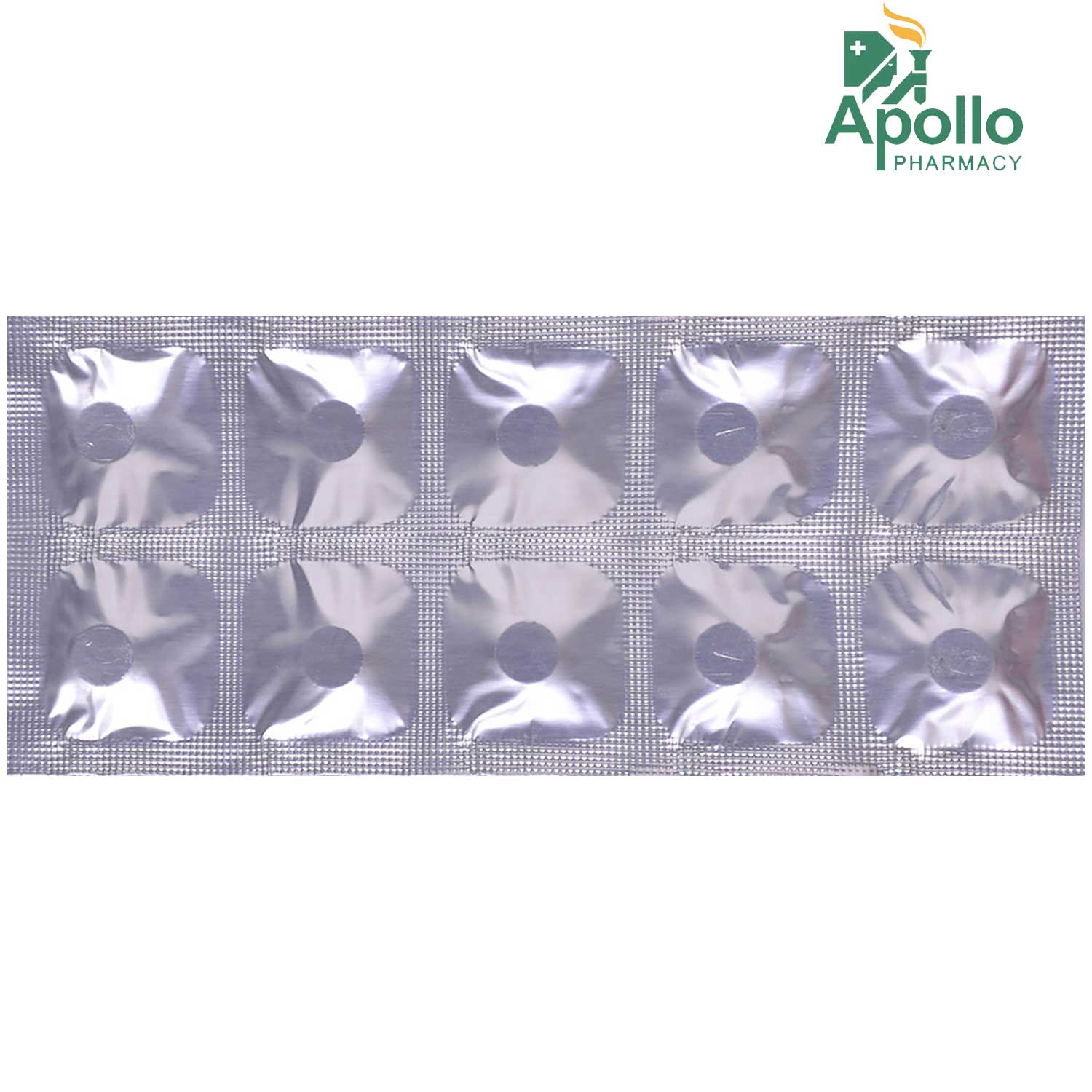
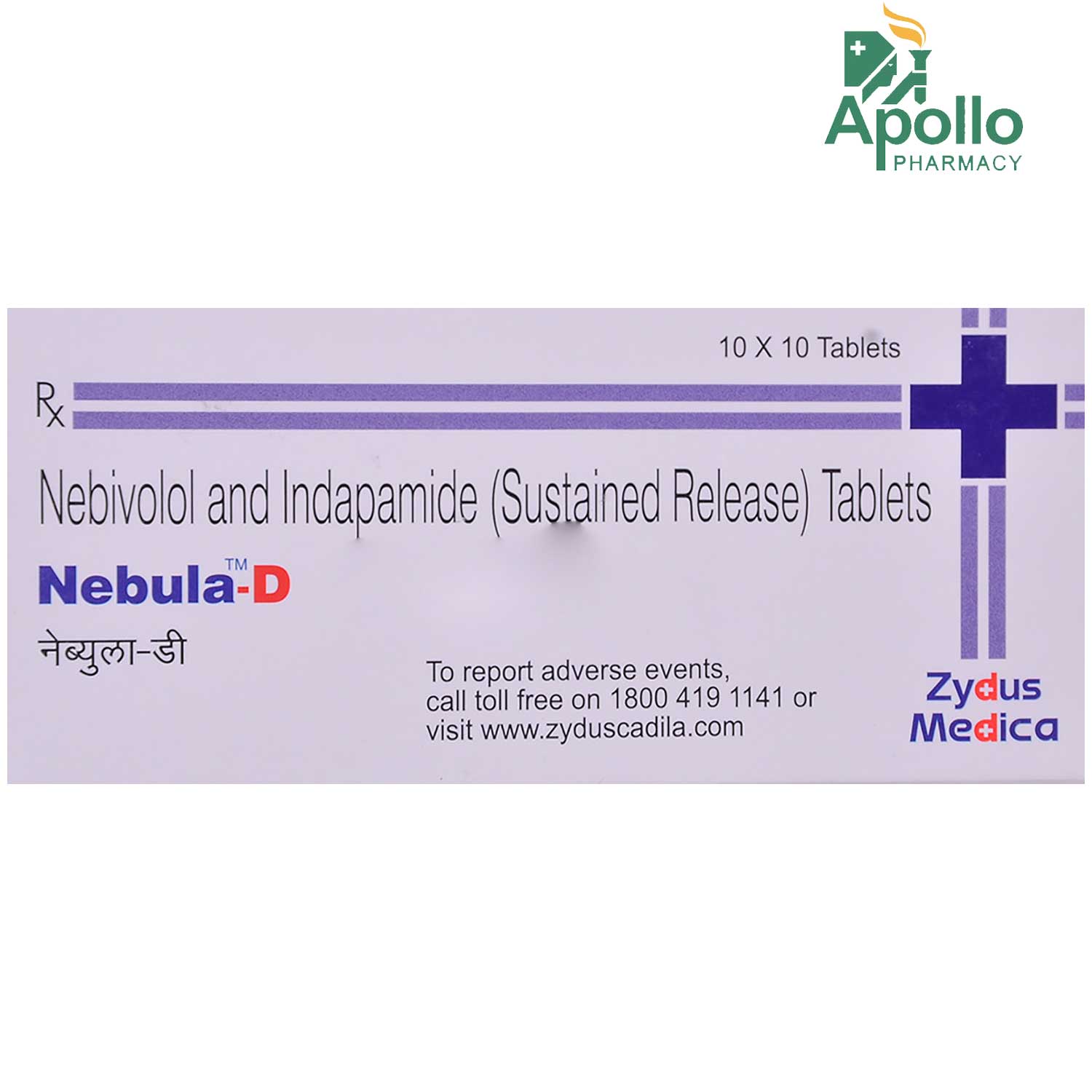
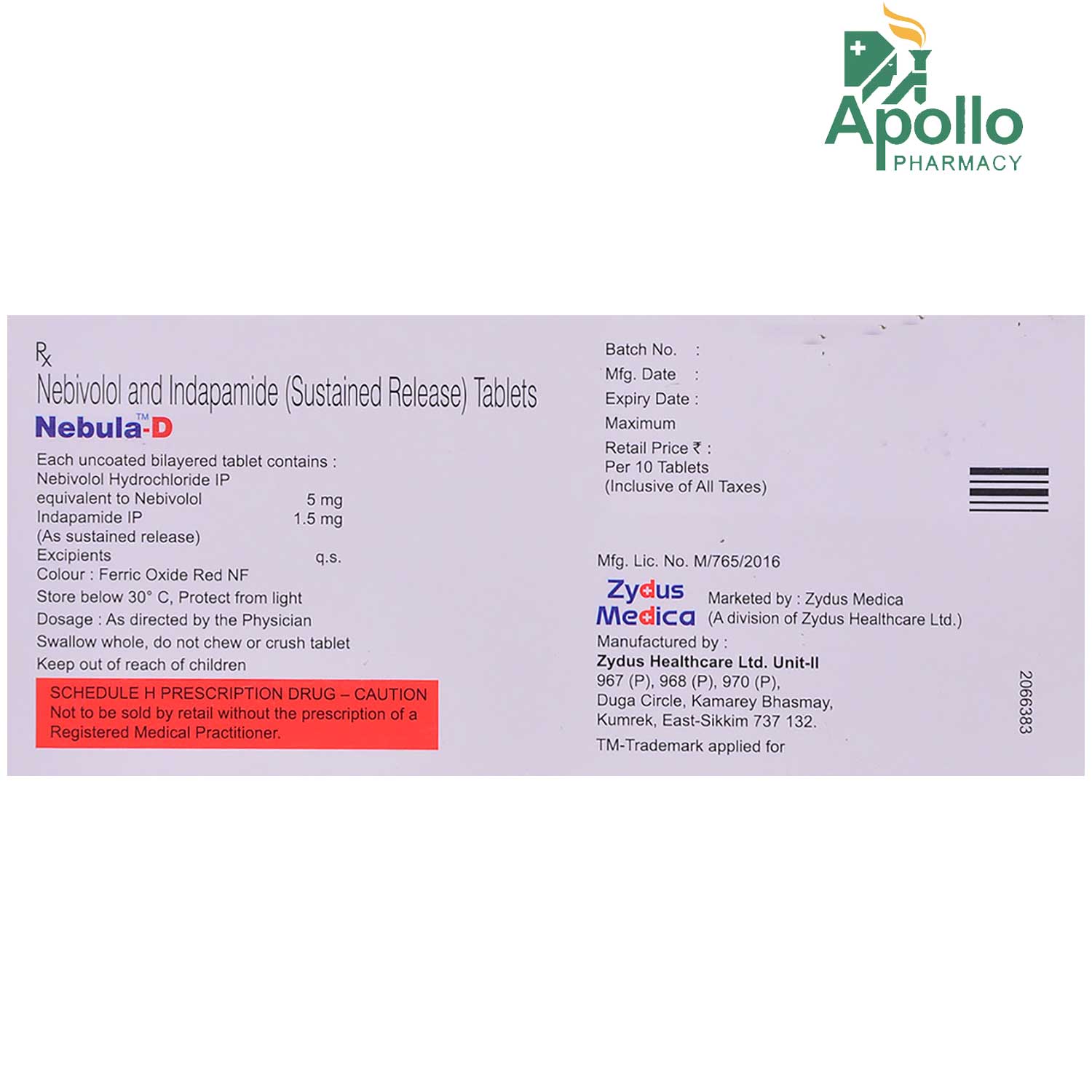
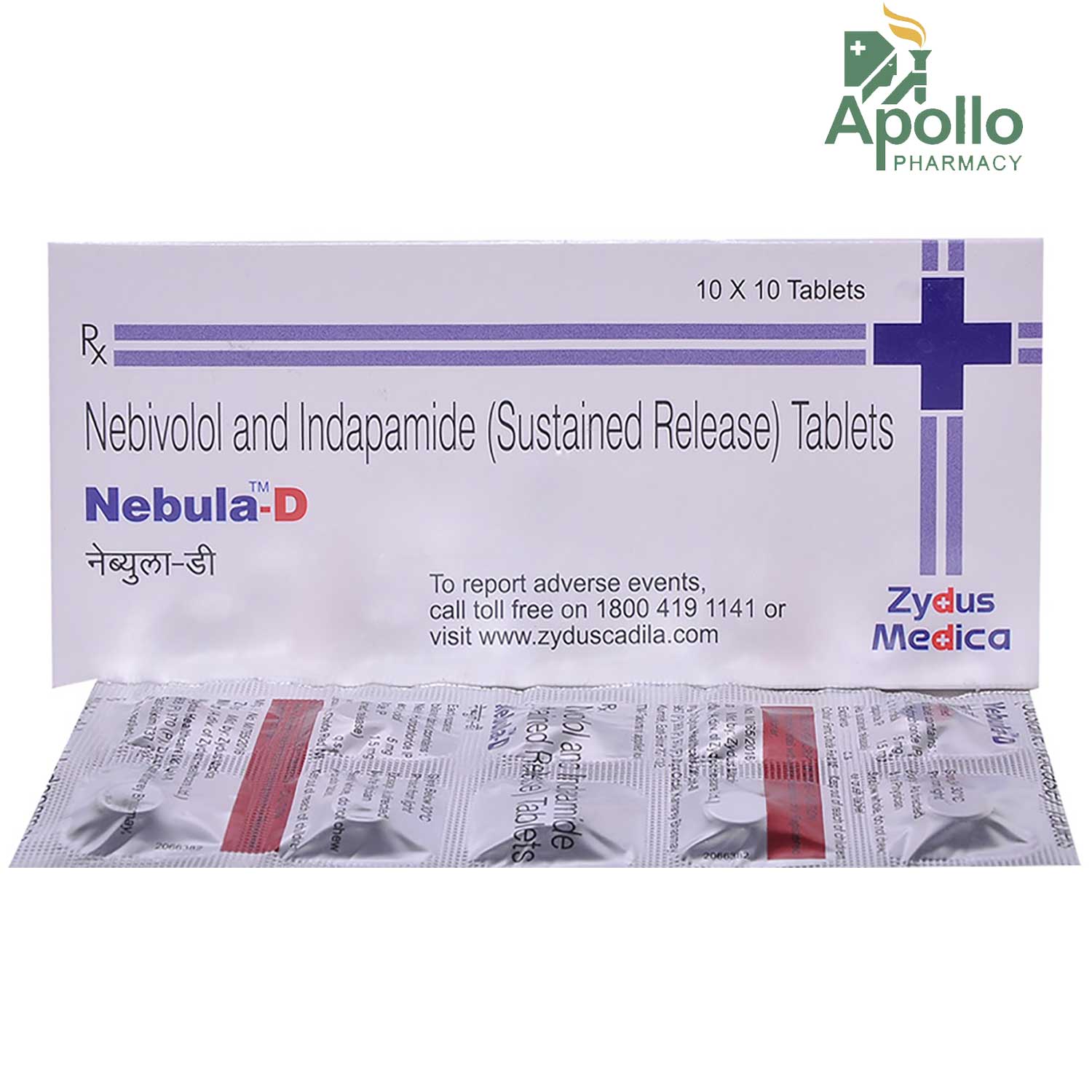

MRP ₹252.5
(Inclusive of all Taxes)
₹37.9 Cashback (15%)
know your delivery time
Provide Delivery Location
Composition :
Manufacturer/Marketer :
Consume Type :
Expires on or after :
Return Policy :

Secure Payment

Trusted by 8 Crore Indians

Genuine Products
Therapeutic Class
Country of origin
Manufacturer/Marketer address
Disclaimer
Alcohol
Safe if prescribed
Alcohol may lower your blood pressure. It would help if you avoided or limit consuming alcohol whilst taking this medicine
Pregnancy
Consult your doctor
It is not recommended to take Nebula-D Tablet while pregnant as it is a pregnancy category C drug, and it is unknown whether it will harm the baby. Please consult your doctor if you have any concerns regarding this; your doctor will prescribe you Nebula-D Tablet only if the benefits outweigh the risks.
Breast Feeding
Consult your doctor
There are limited studies on how Nebula-D Tablet affects the breastfed infants. However, Indapamide in Nebula-D Tablet may pass into the breast milk during breastfeeding. Please consult your doctor before using Nebula-D Tablet if you are a lactating mother.
Driving
Safe if prescribed
Nebula-D Tablet may cause side effects due to lowering of the blood pressure such as dizziness or tiredness. If you feel dizzy or tired when taking this medicine, do not drive or use any tools or machines.
Liver
Consult your doctor
Dose adjustment may be needed. Nebula-D Tablet should be used with caution in patients with liver impairment/liver disease. Please consult your doctor if you have kidney impairment or any concerns regarding this.
Kidney
Consult your doctor
Dose adjustment may be needed. Nebula-D Tablet should be used with caution in patients with kidney impairment/kidney disease. Please consult your doctor if you have kidney impairment or any concerns regarding this.
Children
Safe if prescribed
Nebula-D Tablet is not recommended for use in people below 18 years of age.
About Nebula-D Tablet
Nebula-D Tablet is a combination drug containing antihypertensive medication, primarily used to treat high blood pressure (hypertension). Hypertension (High blood pressure) is a condition in which the force exerted by the blood against the artery walls becomes so high that it causes health problems, such as heart disease. It is also used to reduce strokes and chest pain (angina) caused by the arteries' blockage. In addition to this, Nebula-D Tablet is also used to treat preterm labour.
Nebula-D Tablet contains Nebivolol and Indapamide. Nebivolol is a beta-blocker; that relaxes and widens the blood vessels making it easier for the heart to pump blood to all parts of the body. This helps in decreasing the blood pressure and the risk of having a heart attack or stroke. Indapamide is a thiazide diuretic that inhibits excess salt absorption in the body, resulting in increased chloride, sodium, and water excretion through urine. This diuresis process (increased urine production) and excess salts and fluid removal help lower blood pressure.
Take Nebula-D Tablet as prescribed by your doctor. You are advised to take Nebula-D Tablet for as long as your doctor has prescribed it for you, depending upon your medical condition. You may experience nausea, constipation, fatigue, headache, stomach pain, diarrhoea, indigestion, weakness, dizziness, cough, peripheral oedema (swelling in feet and hands), nervousness, hypertonia (increased muscle tone) in some cases. Most of these side effects of Nebula-D Tablet do not require medical attention and gradually resolve over time. However, if the side effects are persistent, reach out to your doctor.
Try not to stop taking this medicine of your own as it may suddenly increase blood pressure, chest pain or may cause a heart attack. Let your doctor know if you have any liver or heart problems, are pregnant or breastfeeding. You should monitor your blood pressure regularly to be sure that the Nebula-D Tablet is working efficiently. And also, a healthy diet, regular exercise is necessary to keep blood pressure under control. Do not eat grapefruit or drink grapefruit juice while you're taking nifedipine. It can make side effects worse. Even a small reduction in sodium in your diet helps improve your heart's health and reduce blood pressure. Avoid alcohol consumption while taking Nebula-D Tablet as it might lower the blood pressure than normal.
Uses of Nebula-D Tablet
Medicinal Benefits Mweb
Key Benefits
Nebula-D Tablet is a combination drug containing antihypertensive medication, Nebivolol, and Indapamide, primarily used to treat high blood pressure (hypertension). In addition to this, nebivolol also helps prevent increased heart rate and controls heart pumping strength, and indapamide also treats fluid retention and overload (oedema) in congestive heart failure patients. Nebivolol is a beta-blocker; that relaxes and widens the blood vessels making it easier for the heart to pump blood to all parts of the body. This helps in decreasing the blood pressure and the risk of having a heart attack or stroke. Indapamide is a thiazide diuretic that inhibits excess salt absorption in the body, resulting in increased chloride, sodium, and water excretion through urine. This diuresis process (increased urine production) and excess salts and fluid removal help lower blood pressure.
Directions for Use
Side Effects of Nebula-D Tablet
- Nausea
- Constipation
- Fatigue
- Headache
- Stomach pain
- Diarrhoea
- Indigestion
- Weakness
- Dizziness, Infection
- Cough
- Peripheral oedema (swelling in feet and hands)
- Nervousness
Drug Warnings
Do not skip any doses or stop taking Nebula-D Tablet without consulting your doctor. Avoid intake of Nebula-D Tablet if you are allergic to any of its contents. Talk to your doctor if you have heart, kidney, or liver problems. Do not take Nebula-D Tablet if you have low blood pressure, serious circulation problems in arms and legs, very slow heartbeat, serious heart rhythm problems, recent heart failure, asthma, liver function disorder, or metabolic disorder. Avoid taking Nebula-D Tablet if you are pregnant or breast-feeding, and talk to your doctor. Avoid alcohol consumption while taking Nebula-D Tablet as it might lower the blood pressure than normal. Nebula-D Tablet is not recommended for children below the age of 18 years as the efficacy and safety have not been established. Regular monitoring of blood pressure, electrolyte levels, and kidney functioning is advised while taking Nebula-D Tablet .
Drug-Drug Interactions
Drug-Drug Interactions
Login/Sign Up
Taking Droperidol with Nebula-D Tablet can lead to severe heart problems.
How to manage the interaction:
Taking Droperidol with Nebula-D Tablet is not recommended, but can be taken if prescribed by the doctor.
Taking Protriptyline along with Nebula-D Tablet can lead to serious heart problems.
How to manage the interaction:
Taking Protriptyline with Nebula-D Tablet is not recommended, but can be taken if prescribed by the doctor.
Taking Nebula-D Tablet with Thioridazine can increase the risk of heart problems.
How to manage the interaction:
Taking Thioridazine with Nebula-D Tablet is not recommended, but can be taken if prescribed by the doctor.
Co-administration of Nebula-D Tablet with Dofetilide can increase the risk of abnormal heart rhythm.
How to manage the interaction:
Taking Nebula-D Tablet and Dofetilide together can result in an interaction, it can be taken if a doctor has advised it. However, if you experience sudden dizziness, fainting, shortness of breath, rapid heartbeat, weakness, muscle pain, cramps, nausea, or vomiting, consult a doctor immediately. Do not discontinue any medications without a doctor's advice.
Co-administration of Amiodarone together with Nebula-D Tablet may raise the risk of an abnormal heart rhythm.
How to manage the interaction:
Even though Amiodarone and Nebula-D Tablet interact, they can be used if prescribed by a doctor. If you experience abrupt dizziness, lightheadedness, fainting, shortness of breath, or rapid heartbeat, painful muscle cramping, get medical attention. Do not discontinue any medications without consulting a doctor.
Taking Nebula-D Tablet with Lithium can increase the blood levels of lithium.
How to manage the interaction:
Taking Nebula-D Tablet with Lithium can result in an interaction, but it can be taken if a doctor has advised it. However, if you experience symptoms like loose stools, vomiting, drowsiness, shaking of hands and legs, thirst, increased urination, lack of coordination, or muscle weakness, consult a doctor. Do not discontinue any medications without a doctor's advice.
Co-administration of Nebula-D Tablet with Arsenic trioxide can increase the risk of abnormal heart rhythms.
How to manage the interaction:
Taking Nebula-D Tablet and Arsenic trioxide together can result in an interaction, it can be taken if a doctor has advised it. However, if you experience sudden dizziness, lightheadedness, fainting, shortness of breath, rapid heartbeat, weakness, tiredness, drowsiness, confusion, muscle pain, cramps, nausea, or vomiting, consult a doctor immediately. Do not discontinue any medications without a doctor's advice.
Co-administration of Tizanidine with Nebula-D Tablet may reduce blood pressure greatly leading to side effects.
How to manage the interaction:
Although taking Nebula-D Tablet and Tizanidine together can cause an interaction, it can be taken if a doctor has suggested it. However, if you notice any of these signs - feeling dizzy, having a headache, feeling lightheaded, or fainting, Consult a doctor. Do not discontinue any medications without a doctor's advice.
Using Aminolevulinic acid with Nebula-D Tablet, your skin becomes more sensitive to strong light. This increases your risk of getting a bad sunburn.
How to manage the interaction:
Although taking Nebula-D Tablet and Aminolevulinic acid together can cause an interaction, it can be taken if a doctor has suggested it. After treatment, you should wait 48 hours before exposing your eyes, and skin, to any bright lights indoors. Do not discontinue any medications without a doctor's advice.
When Nebula-D Tablet and Dronedarone are taken together, the risk of an irregular heart rhythm increases.
How to manage the interaction:
Taking Nebula-D Tablet and Dronedarone together can possibly result in an interaction, it can be taken if a doctor has advised it. However, if you experience sudden dizziness, lightheadedness, fainting, shortness of breath, rapid heartbeat, weakness, tiredness, drowsiness, confusion, muscle pain, cramps, nausea, or vomiting, consult a doctor immediately. Do not discontinue any medications without a doctor's advice.
Drug-Food Interactions
Drug-Food Interactions
Login/Sign Up
Drug-Diseases Interactions
Drug-Diseases Interactions
Login/Sign Up
Drug-Drug Interactions Checker List
- HYDROCHLOROTHIAZIDE
- FUROSEMIDE
- CHLORTHALIDONE
- RAMIPRIL
- METOPROLOL
- AMLODIPINE
- ALPRAZOLAM
- AMISULPRIDE
- IBUPROFEN
- NAPROXEN
- LITHIUM
- INSULIN GLARGINE
- METFORMIN
- ESOMEPRAZOLE
- PREDNISONE
- SILDENAFIL
Habit Forming
Special Advise
- Monitor your blood pressure regularly and seek medical advice if you notice any drastic fluctuations.
- Let your doctor know if you are advised for any blood examinations as, diuretics like Indapamide can cause changes in the laboratory parameters like low potassium levels in the blood, low sodium in the blood, low blood pressure, increase in uric acid, increase in blood glucose levels in diabetic patients, increase in calcium levels in the blood, and increase in the liver enzyme levels.
- Athletes should be aware that Indapamide in Nebula-D Tablet gives a positive reaction in doping tests.
Diet & Lifestyle Advise
- Keep your weight under control with a body mass index (BMI) between 19.5 and 24.9.
- Do regular physical activity or exercise for at least 150 minutes per week, or about 30 minutes most days of the week. Doing this can help you to lower your raised blood pressure by about 5 mm of Hg.
- Limit sodium chloride intake (table salt) in your daily diet to 2300 mg per day or less than 1500 mg is ideal for most adults.
- If you are taking alcohol, use only one serving for women and two servings for men.
- Quit smoking to lower the risk of heart diseases.
- Avoid chronic stress as it can raise your blood pressure. Try to enjoy and spent time with your loved ones to cope with stress.
- Monitor your blood pressure daily, and if you notice any fluctuations frequently, please contact your doctor immediately.
- Try including heart-healthy omega 3 fatty acid-containing foods in your daily diet. You can also use low-fat cooking oils like olive oil, soybean oil, canola oil, and coconut oil that help in lowering your elevated blood pressure.

Have a query?
Buy best Cardiology products by
Torrent Pharmaceuticals Ltd
Sun Pharmaceutical Industries Ltd
Lupin Ltd
Intas Pharmaceuticals Ltd
Cipla Ltd
Micro Labs Ltd
Macleods Pharmaceuticals Ltd
Abbott India Ltd
Ajanta Pharma Ltd
Ipca Laboratories Ltd
Eris Life Sciences Ltd
Mankind Pharma Pvt Ltd
Lloyd Healthcare Pvt Ltd
Dr Reddy's Laboratories Ltd
Glenmark Pharmaceuticals Ltd
Emcure Pharmaceuticals Ltd
Alembic Pharmaceuticals Ltd
Alkem Laboratories Ltd
East West Pharma India Pvt Ltd
USV Pvt Ltd
Zydus Healthcare Ltd
Aristo Pharmaceuticals Pvt Ltd
Elbrit Life Sciences Pvt Ltd
J B Chemicals & Pharmaceuticals Ltd
Zydus Cadila
Akumentis Healthcare Ltd
Alteus Biogenics Pvt Ltd
Hbc Life Sciences Pvt Ltd
Fusion Health Care Pvt Ltd
Troikaa Pharmaceuticals Ltd
La Renon Healthcare Pvt Ltd
Corona Remedies Pvt Ltd
Jubilant Lifesciences Ltd
Medley Pharmaceuticals Ltd
Knoll Healthcare Pvt Ltd
Msn Laboratories Pvt Ltd
Zuventus Healthcare Ltd
Cadila Pharmaceuticals Ltd
Blue Cross Laboratories Pvt Ltd
Lividus Pharmaceuticals Pvt Ltd
Morepen Laboratories Ltd
Ranmarc Labs
Shrrishti Health Care Products Pvt Ltd
Sanofi India Ltd
Steris Healthcare
Elder Pharmaceuticals Ltd
Primus Remedies Pvt Ltd
Unison Pharmaceuticals Pvt Ltd
Eswar Therapeutics Pvt Ltd
Knoll Pharmaceuticals Ltd
Tas Med India Pvt Ltd
Systopic Laboratories Pvt Ltd
Indiabulls Pharmaceuticals Pvt Ltd
Leeford Healthcare Ltd
Sinsan Pharmaceuticals Pvt Ltd
Biochem Pharmaceutical Industries Ltd
Cadila Healthcare Ltd
Azkka Pharmaceuticals Pvt Ltd
Nirvana India Pvt Ltd
Orsim Pharma
Prevego Healthcare & Research Pvt Ltd
Econ Healthcare
Elinor Pharmaceuticals (P) Ltd
FDC Ltd
Sunij Pharma Pvt Ltd
Nicholas Piramal India Ltd
Astra Zeneca Pharma India Ltd
Pfizer Ltd
Lia Life Sciences Pvt Ltd
Shine Pharmaceuticals Ltd
Elicad Pharmaceuticals Pvt Ltd
Indoco Remedies Ltd
Proqol Health Care Pvt Ltd
Vasu Organics Pvt Ltd
Biocon Ltd
Opsis Care Lifesciences Pvt Ltd
Johnlee Pharmaceuticals Pvt Ltd
Merck Ltd
Wockhardt Ltd
Auspharma Pvt Ltd
Ergos Life Sciences Pvt Ltd
Lakshya Life Sciences Pvt Ltd
Ordain Health Care Global Pvt Ltd
Pficus De Med Pvt Ltd
ALICAN PHARMACEUTICAL PVT LTD
RPG Life Sciences Ltd
Glynis Pharmaceuticals Pvt Ltd
Orris Pharmaceuticals
Samarth Life Sciences Pvt Ltd
Aprica Pharmaceuticals Pvt Ltd
Aretaeus Pharmaceuticals Pvt Ltd
Koye Pharmaceuticals Pvt Ltd
Neocardiab Care
Retra Life Science Pvt Ltd
Alniche Life Sciences Pvt Ltd
Alvio Pharmaceuticals Pvt Ltd
Arkas Pharma Pvt Ltd
Atos Lifesciences Pvt Ltd
Divine Savior Pvt Ltd
Metalis Lifesciences Pvt Ltd
Customers Also Bought
Recommended for a 30-day course: 3 Strips


